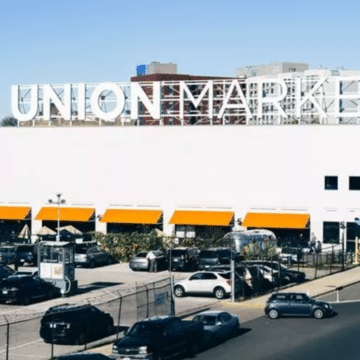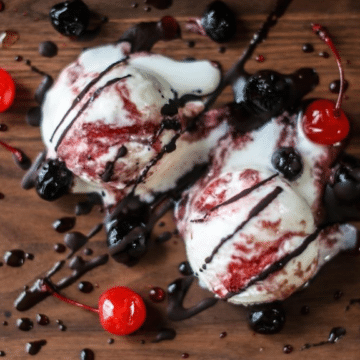Originally published in Washington City Paper
Bartender Jason Strich is gluing $100 worth of plastic human skulls to the inside of a black box—for the second time. The heads nearly rolled away earlier when a gust of wind knocked them over while he was loading his car. Meanwhile, fellow bartender Owen Thomson is measuring out straw thatching.
They’ve got about four hours left until their Sunday night tiki-themed cocktail pop-up at Cafe Saint-Ex begins, and they still need to finish plastering bamboo to the walls, kegging up the draft drinks, assembling elaborate garnishes out of pineapple leaves and flowers, and crushing a few hundred pounds of ice.
“Have we ordered ice?” Strich stops from working on his decorative skull box to ask. “Do we have a tablecloth for crushing?… Did you bring your baseball bats?”
Thomson, who works at Cafe Saint-Ex, Bar Pilar, and Rose’s Luxury, and Strich of Hank’s Oyster Bar arrived at the basement bar at 11 a.m. with four carloads of stuff, including a smoke machine, plastic leis, dry ice, and power tools. But the DIY venture started long before that. Strict even found an old trunk on Craigslist, refinished it, and outfitted it with custom gold leaf tap handles from which to pour draft cocktails.
The goal is transform the bare bones space not just into any tiki bar, but into Chicago tiki bar Three Dots and a Dash, one of Thomson’s favorite spots from his travels across the country. The one-night event is the first in a series of pop-ups called Guerilla Drinks, in which the duo will attempt to recreate a bar from another place and/or time every other month. To do so, the bartenders spent somewhere around $3,000 on booze, equipment, and decorations. (For about the same amount, they could have also purchased about 10 round-trip flights to Chicago.)
“We were kind of tired of the more generic style cocktail party, and we wanted to do something bigger on a grander scale,” Thomson says. “We also just wanted to work together and have fun.”
Turning a profit is not really the point: They just hope not to lose any money.
That’s pretty much how it goes for most bar and restaurant pop-ups, of which there seems to be another one every day now. For something so fleeting, it requires an enormous amount of foresight and creativity to turn a space into something it’s not. The day of a pop-up, it’s not uncommon for hosts to put in 16 or 17 hours. And someone’s sister and her boyfriend (like Thomson’s) will inevitably be recruited as handymen, bussers, and servers. If the event recoups its expenses, that’s generally considered a success.
“It’s kind of like throwing a mini-wedding,” says former Tallula chef Rob Rubba, who recently held a one-night, multi-course pop-up previewing his forthcoming restaurant Hazel in the Dolcezza gelato factor near Union Market. Aside from the food, there’s a long list of considerations: How many guests can we invite? Where can we rent tables? What kind of chairs? What’s our color scheme? And like wedding planning, “everyone’s equally as stressed out, nervous, cold feet, the whole thing,” Rubba says.
Dolcezza, which has become a popular pop-up venue, has a six-burner stove-top with an oven underneath—plenty for a gelato operation, but not for someone preparing a seven-course meal for nearly 60 people. Rubba tried to plan dishes—like a whole roasted duck—that wouldn’t require so much attention right then and there. He did most of his prep work at Neighborhood Restaurant Group’s commissary, right down the block. “I had like a 25-yard stretch to run warm food, so it wasn’t too bad,” he says. “But if someone from another group was doing it, I’d feel bad for them.” While some sauces were prepped a couple days in advance, Rubba worked from 8:30 a.m. to 3 a.m. the day of his pop-up.
You might think it would be easier to prep for a pop-up in an actual restaurant, or at least a bar with a full kitchen. But that’s not necessarily that case, as Maison Dixon’s Adam Cox has found out. Cox, who works for the Department of Homeland Security, and Granville Moore’s owner Teddy Folkman co-host monthly-ish Southern comfort food pop-ups featuring Nashville-style hot chicken at 51st State Tavern or Capitol Lounge, where Folkman is a partner. (Maison Dixon is unrelated to similarly named biscuit pop-up Mason Dixie.) “You don’t really think about this until you try to do some-thing like a pop-up, but kitchens are set up to serve the food that’s normally on their menu,” Cox says. “You kind of have to figure out, ‘How do I do my mac and cheese in a pizza oven?’”
Working out of an existing restaurant also means working around another restaurant’s schedule. Cox can’t just go into the kitchen at Capitol Lounge and start prepping whenever he wants, because they’re running their business. He’ll sometimes start cooking at Granville Moore’s, which is closed for lunch, and then move over to Capitol Lounge after their lunch service. He’ll also store stuff at multiple locations, because the host kitchens most likely already have a full fridge.
“You’re moving a lot of stuff around a lot,” Cox says. Which can cause other problems: “You end up spilling in your car as you’re moving… You’re always kind of [thinking], ‘Can I make it over this speed bump without spilling chili or spilling broth everywhere?’”
Managing inventory is also a guessing game. A restaurant can buy chicken and use it the next day if it doesn’t sell out. For Maison Dixon, it’s a delicate balance of not over-ordering, which wastes product and money, and under-ordering, which can anger guests if everything sells out an hour into the evening. It’s always a gamble if people aren’t buying tickets in advance, because they don’t know if 10 people will come—or 200.
Finding good help can be tricky, too. Capitol Lounge lets Maison Dixon use its staff, and they split the night’s revenue. Hazel’s Rubba had some non-cooks helping him in the kitchen and Neighborhood Restaurant Group’s Director of Operations running food. Pastry chef Tiffany MacIsaac, who’s hosted a couple of pop-ups at Cork Market and Navy Yard’s Ice Cream Jubilee in preparation for her Buttercream Bakeshop, occasionally recruits one of her former sous chefs to help bake some cookies or help assemble cakes.
But MacIsaac sees much more potential for chaos with a restaurant pop-up as opposed to a retail pop-up: “You’re working with servers who don’t know your food. And you don’t necessarily know your food. And you’re pulling friends to help you cook.”
Amateur or untrained service has consequences: MacIsaac recalls going to one unnamed pop-up where servers didn’t bring forks and the food started to get cold. “I can’t be mad at them, because they’re just doing this for a couple days, and there’s not that muscle memory of doing stuff over and over again,” she says. “But at the same time, you’re paying a premium to go to these dinners.”
It’s not uncommon for relatively unknown chefs to host pop-ups where they charge $100 or more a seat. But even then, they’re not making enough to finance their future restaurant plans. “There are a lot of reasons to do [a pop-up], the least of which is making money,” MacIsaac says.
The real goal is exposure or to test out recipes. In a best case scenario, pop-ups can help convince investors to help fund a permanent location. That was part of the thinking behind EatsPlace in Park View, which became D.C’s first “pop-uppery” when it opened in the fall. The food incubator gives chefs and restaurateurs a place to test drive their concepts for a couple weeks or months at a time. EatsPlace supplies a host, bartender, and dishwasher, but the restaurants bring their own servers and cooks.
Meanwhile, crowdfunding platform EquityEats is in the process of opening a “pop-up megaplex” called Prequel in the former LivingSocial event space at 918 F St. NW. When it debuts this spring, the building will be able to house up to five restaurant or bar pop-ups at a time. The goal is to create an infrastructure that makes the behind-the-scenes workings of pop-ups as easy as possible.
“It can be a process to take over someone else’s space and to come up with an agreement that makes sense… With Prequel, we want everyone to be able to come in and do their thing and not have so much overhead and legal back-and-forth,” says Steve Lucas, EquityEats’ VP of strategy and communications.
Prequel will also have its own core staff of servers and cooks who can help execute a chef’s menu. That will theoretically help free chefs to come out and talk to guests during the meal—something many are too swamped with supervising cooking and serving to do at other pop-ups. After all, the mission of Prequel is to create a place where potential investors could check out (and then ideally want to fund) concepts using EquityEats’ crowdfunding platform.
Then again, sometimes a pop-up is just a pop-up, not a means to an end. Guerilla Drinks’ Thomson and Strich aren’t planning to open a new D.C. outpost for Three Dots and a Dash; they’re not even planning to open a tiki bar. “It’s always good to have a bunch of bamboo laying around. My backyard might become very festive all of a sudden,” Thomson says of what he’ll do with the decorations. For them, it’s just a fun side project.
I ask Thomson if it makes him sad that they’ve put all this work into something that will all get torn down tomorrow.
“That’s kind of the cool part, right?” he says. “If you weren’t here today, you weren’t here.”
Eatery tips? Food pursuits? Send suggestions to hungry@washingtoncitypaper.com.
Photo of Jason Strich and Owen Thomson by Darrow Montgomery


